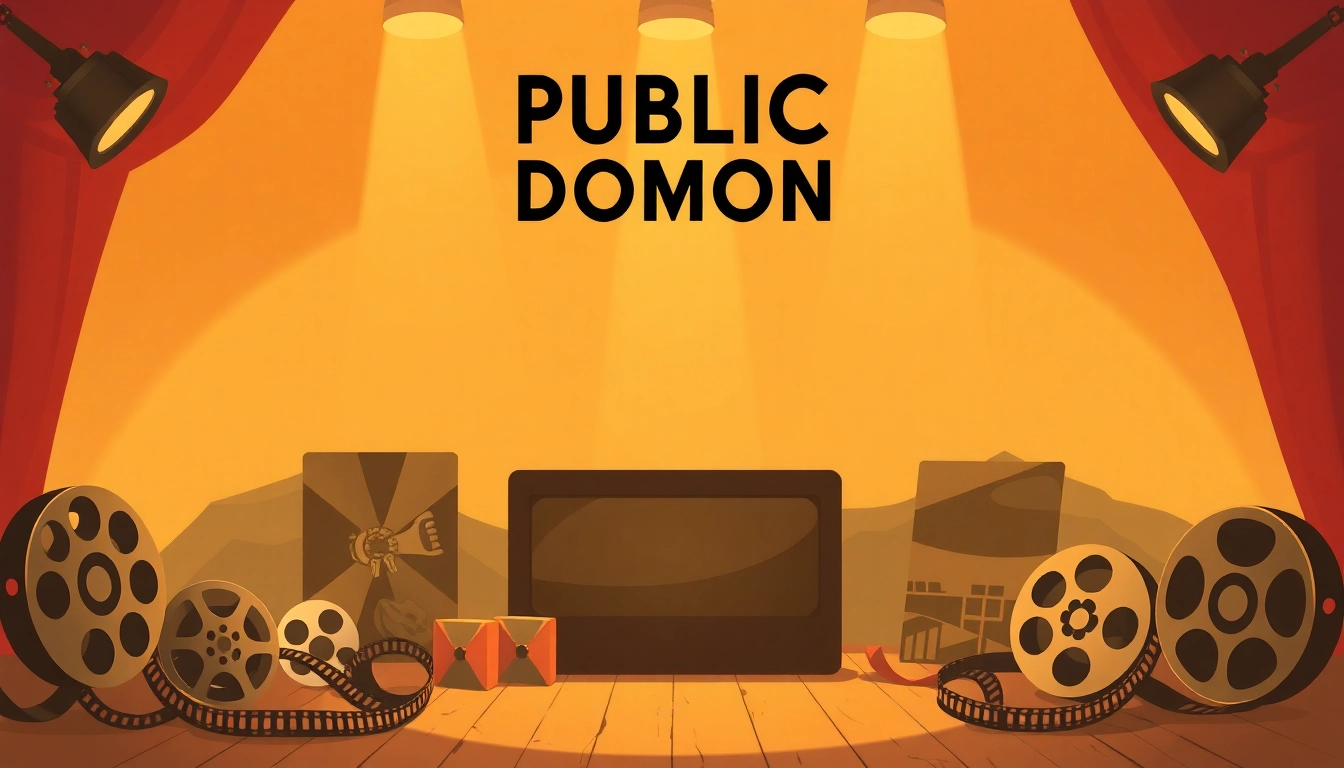Understanding Public Domain Films
Public domain films are an often overlooked treasure trove of cinematic history. Defined as films that are no longer under copyright protection, these films can be freely accessed, shared, and reused by anyone. Understanding public domain films begins with grasping the essence of what makes a film public domain and why this aspect is significant in the realm of cinema.
What Are Public Domain Films?
A public domain film is one that is not protected by copyright. The reasons behind a film’s transition to the public domain vary significantly, but they often occur when copyright terms expire. In the United States, for example, films generally enter the public domain 95 years after their release date. The public domain films era is essential for fostering cultural access, creativity, and scholarship. Today, films produced before 1928 automatically fall into the public domain, allowing modern audiences to view and appreciate them without any legal restrictions.
The Importance of Public Domain in Film
The public domain serves as a crucial pillar for the preservation and dissemination of film history. It allows filmmakers, educators, and enthusiasts to access a wide array of films that reflect diverse cultural landscapes without the constraints of copyright law. This accessibility fosters educational opportunities and supports the arts, encouraging new creations inspired by classic works. Furthermore, public domain films enable the revival of lost narratives, giving forgotten genres and themes a second life.
How Copyright Affects Film Distribution
Copyright laws significantly influence film distribution and consumption, dictating who can view, replicate, or adapt a film. Historically, the duration of copyright has evolved, with terms extending through legislation that aimed at protecting creators’ rights. Films made after 1978 receive copyright protection for the life of the creator plus an additional 70 years. The process of navigating copyright requires vigilance, as incorrectly using copyrighted material can lead to severe legal ramifications. Comparatively, the public domain offers a safe haven for both creative professionals and amateur filmmakers alike, providing materials that can be freely incorporated into new works, re-edited, or released to the public without legal constraints.
Popular Public Domain Films You Should Watch
The rich tapestry of public domain films includes a variety of genres and styles that have stood the test of time. Below are classifications of notable films that highlight this diversity.
Classic Films from the Golden Age
The Golden Age of Hollywood produced numerous films that have since entered the public domain. Among them are iconic works such as The Black Cat (1934), an early horror classic featuring Boris Karloff and Bela Lugosi, showcasing the atmospheric storytelling of the time. Other remarkable entries include His Girl Friday (1940), a revolutionary screwball comedy that pushed the boundaries of gender roles in film, and Night of the Living Dead (1968), which has had a lasting impact on the horror genre and pop culture.
Notable Horror Movies in the Public Domain
The horror genre boasts a significant number of public domain films, some of the most influential in cinematic history. Nosferatu (1922) remains a seminal work in horror, revered for its expressionist style and atmospheric storytelling. Plan 9 from Outer Space (1959), often dubbed the “worst movie ever made,” has gained a cult following due to its unintentional comedic value and charm. Films like these continue to inspire and entertain those who explore the darker themes in public domain cinema.
Family-Friendly Public Domain Films
Family-friendly content is well-represented in the public domain, making it a fantastic resource for quality entertainment suitable for all ages. Classic animated films such as Little Nemo (1921) and Snow White (1933) not only entertain but also preserve the artistry of early animation. Additionally, live-action adventures like Peter Pan (1924) provide timeless tales that can be enjoyed by generations, enriching family viewing experiences without any financial burden.
Finding Public Domain Films Online
Finding public domain films online has never been easier, thanks to numerous resources dedicated to preserving and sharing these cinematic gems. Knowing where to look can significantly enhance your film-watching experience.
Top Resources for Streaming Public Domain Films
Downloading Public Domain Films Legally
For viewers who prefer offline access, many platforms allow users to download public domain films legally. Websites like LibriVox offer free audiobooks, but they also host several films available to download. Check the licensing on each site to ensure that the films are indeed in the public domain before downloading.
Understanding Film Licensing and Usage Rights
When engaging with public domain films, it is essential to understand the nuances of film licensing and usage rights. While public domain materials are generally free to use, some films may contain elements (like soundtracks or character likenesses) that are still under copyright. For any project incorporating public domain content, verifying the elements involved is crucial to avoid inadvertent copyright violations.
Creating a Collection of Public Domain Films
Curating a personal collection of public domain films can be a rewarding endeavor that allows you to explore cinematic history intimately. Knowing how to approach this process can enhance your appreciation for films that shaped the industry.
How to Curate Your Favorite Films
Creating a personal library of public domain films involves selecting films that resonate with your interests and preferences. Start by exploring different genres and eras, noting films that intrigue you. Websites that list public domain films can streamline this process. As you discover titles you enjoy, create categories or lists—either digital or physical—that make it easy to revisit them. Consider hosting regular movie nights centered around your collection, sharing these films with family and friends, and sparking discussions about their historical significance.
Tips for Film Preservation and Archiving
Once you’ve amassed a collection, preserving the quality of these films becomes paramount. For physical media, store films in a cool, dry place away from direct sunlight. If you’re dealing with digital files, utilize reliable storage solutions, such as cloud services or external hard drives, to prevent loss. Regularly check file integrity and ensure that your files remain in commonly accepted formats for longevity.
Sharing Public Domain Films with Others
Sharing public domain films can help cultivate appreciation for classics and empower others to access film history. Organize screenings at local community centers, schools, or even online watch parties to introduce audiences to these enriching films. Utilize social media to promote your screenings, share insights about the films, and foster discussions. This communal approach not only builds connections but also encourages others to explore the vast world of public domain cinema.
The Future of Public Domain Films
As the landscape of copyright laws continues to shift, the future of public domain films remains both ripe with opportunity and complexity. Understanding industry trends and technological advancements can illuminate what lies ahead.
Impacts of Changing Copyright Laws
Recent changes in copyright policies can significantly affect the public domain landscape. Legislative adjustments often lead to extensions in copyright terms that can delay a film’s entry into the public domain. Advocacy movements emphasize the importance of maintaining and protecting public domain works to ensure diverse access to cultural materials. Staying informed on these issues is vital for educators, filmmakers, and enthusiasts alike to ensure that the public domain remains a robust source of public access and creativity.
The Role of New Technology in Film Access
Advancements in technology, particularly in streaming services and digital archives, are democratizing access to public domain films. Innovative platforms leverage sophisticated algorithms to recommend classic films based on user interests, creating a more personalized viewing experience. Additionally, emerging technologies such as artificial intelligence can aid in the restoration of old films, allowing new generations to enjoy these forgotten treasures in higher quality.
Potential New Additions to the Public Domain
The upcoming years will see numerous films entering the public domain, providing exciting opportunities for rediscovery. As of 2024, all films released before 1928 will be available, which notably includes many silent films and early talkies. Film scholars, historians, and enthusiasts eagerly anticipate these additions as they provide insights into early cinema and reflect the ever-changing nature of storytelling through film.
In conclusion, public domain films embody rich narratives, emotional connections, and artistic innovation. They stand as a testament to the enduring power of storytelling and continue to inspire, educate, and entertain. By embracing these films, we not only preserve our cinematic heritage but also cultivate creativity for generations to come.



